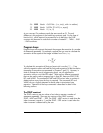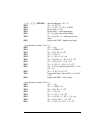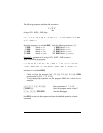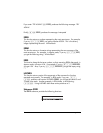
Page 21-60
To avoid an infinite loop, make sure that start_value < end_value.
Example – calculate the summation S using a FOR…NEXT construct
The following program calculates the summation
Using a FOR…NEXT loop:
« 0 → n S « 0 n FOR k k SQ S + ‘S‘ STO NEXT S “S” →TAG » »
Store this program in a variable @@S2@@. Verify the following exercises: J
3 @@@S2@@ Result: S:14 4 @@@S2@@ Result: S:30
5 @@@S2@@ Result: S:55 8 @@@S2@@ Result: S:204
10 @@@S2@@ Result: S:385 20 @@@S2@@ Result: S:2870
30 @@@S2@@ Result: S:9455 100 @@@S2@@ Result: S:338350
You may have noticed that the program is much simpler than the one stored in
@@@S1@@. There is no need to initialize k, or to increment k within the program. The
program itself takes care of producing such increments.
The FOR…STEP construct
The general form of this statement is:
start_value end_value FOR loop_index program_statements
increment STEP
The start_value, end_value, and increment of the loop index can be positive
or negative quantities. For increment > 0, execution occurs as long as the
index is less than or equal to end_value. For increment < 0, execution
occurs as long as the index is greater than or equal to end_value. Program
statements are executed at least once (e.g.,
1 0 START 1 1 STEP returns 1)
∑
=
=
n
k
kS
0
2


















